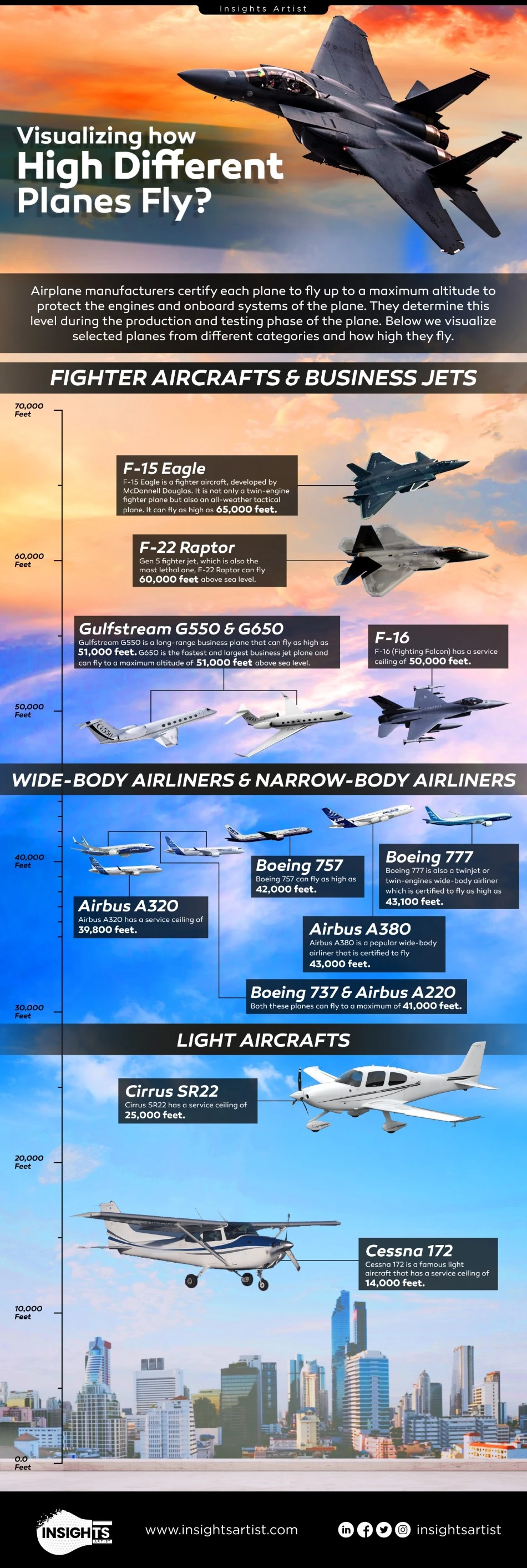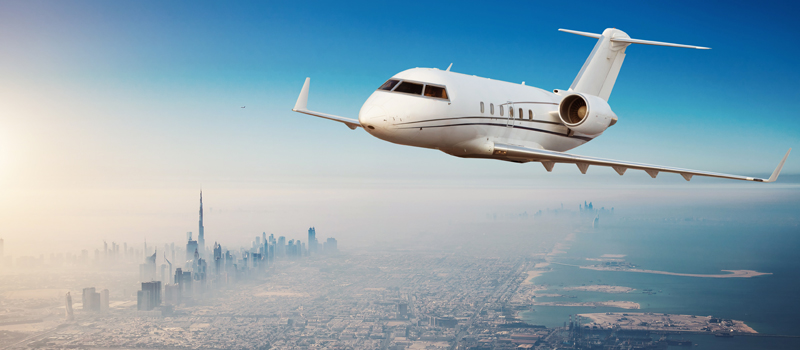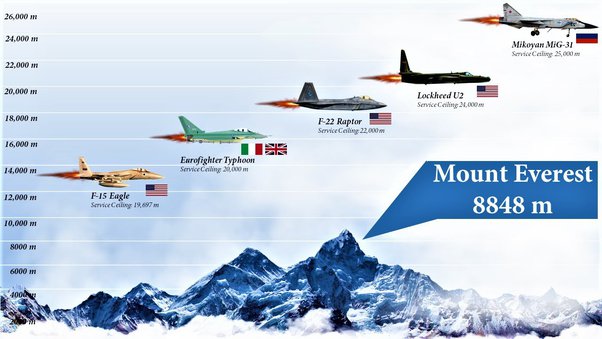Planes typically fly at altitudes of 30,000 to 40,000 feet. These heights ensure a smooth and efficient flight, as well as avoiding any obstacles on the ground.
Flying has revolutionized the way we travel and connect with different parts of the world. From short domestic flights to long-haul international trips, airplanes have made it possible to reach destinations that would have been impossible by other means of transportation.
But have you ever wondered how high airplanes fly? This question might seem simple, but the answer is more complex than you might expect. In this blog post, we will explore the altitude of planes, why they fly so high, and the factors that determine their cruising altitude. So fasten your seatbelts and get ready to take off!
The Sky’s The Limit
Discover how high planes soar in the sky! Commercial jets typically fly at altitudes ranging from 30,000 to 40,000 feet. However, military aircraft can reach heights exceeding 60,000 feet, pushing the boundaries of aviation possibilities.
Factors Determining Flight Altitude
In the world of aviation, the altitude at which planes fly is determined by several key factors. These factors play a crucial role in ensuring safe and efficient air travel for passengers. Let’s explore some of the main factors that influence flight altitude:
- 1. Aircraft Type: Different types of aircraft have varying capabilities and performance characteristics. Some planes are designed for short-haul flights, while others are built for long-haul journeys. The type of aircraft being used will determine its optimal flight altitude.
- 2. Weight and Load: The weight of the aircraft, including passengers, cargo, and fuel, affects its ability to reach higher altitudes. Heavier planes may have limitations on how high they can fly due to increased fuel consumption and reduced maneuverability.
- 3. Weather Conditions: Weather conditions such as temperature, wind speed, and atmospheric pressure can impact the altitude at which planes can safely operate. Extreme weather conditions may require planes to fly at lower altitudes to avoid turbulence or other hazards.
- 4. Air Traffic: The density of air traffic in a particular airspace can also affect flight altitude. Air traffic controllers strategically assign altitudes to planes to ensure safe separation between aircraft.
Altitude Limits For Commercial Aircraft
Commercial aircraft, such as those used by airlines, have specific altitude limits that they must adhere to. These limits are determined by regulatory authorities and are designed to ensure the safety and efficiency of air travel.
The altitude limits for commercial aircraft can vary depending on factors such as:
- 1. Aircraft Design: The design and capabilities of the aircraft play a significant role in determining its altitude limits. Factors such as engine power, wing configuration, and structural strength all contribute to the maximum altitude a commercial plane can reach.
- 2. Regulatory Requirements: Aviation regulatory bodies set specific altitude limits for commercial aircraft to ensure uniformity and safety standards across the industry. These limits take into account factors such as air traffic control, airspace restrictions, and emergency procedures.
- 3. Operational Considerations: Airlines also consider operational factors when determining altitude limits for their aircraft. These considerations may include factors such as fuel efficiency, passenger comfort, and route optimization.
Overall, the altitude at which planes fly is a carefully calculated balance between various factors to ensure safe and efficient air travel. By considering factors such as aircraft type, weight and load, weather conditions, air traffic, aircraft design, regulatory requirements, and operational considerations, airlines can determine the optimal altitude for their flights.

Credit: insightsartist.com
Cruising Above The Clouds
When it comes to air travel, have you ever wondered how high do planes fly? Cruising above the clouds, commercial flights soar through the sky at impressive altitudes, offering passengers a unique experience and pilots a strategic advantage.
Typical Altitudes For Commercial Flights
Commercial flights typically cruise at altitudes ranging from 31,000 to 38,000 feet. This equates to approximately 5.9 to 7.2 miles above the Earth’s surface. These altitudes are carefully chosen to optimize fuel efficiency and minimize air resistance, allowing for smoother and more efficient travel.
Benefits Of High-altitude Cruising
- Reduced turbulence, providing a more comfortable journey for passengers
- Increased fuel efficiency, lowering operational costs for airlines
- Access to faster tailwinds, reducing travel time for long-haul flights
- Improved safety, as higher altitudes offer greater separation between aircraft
Jet Streams And Flight Paths
Jet streams are powerful air currents that flow high up in the Earth’s atmosphere. They play a crucial role in determining the altitude at which planes fly and the flight paths they take. Understanding the influence of jet streams on altitude and how pilots navigate these high-altitude air currents is essential for safe and efficient air travel.
Influence Of Jet Streams On Altitude
Jet streams are fast-flowing, narrow bands of air that blow from west to east in the upper levels of the troposphere. They can reach speeds of up to 200 miles per hour, making them a valuable resource for commercial aviation. Airlines often take advantage of jet streams to reduce fuel consumption and shorten flight times.
When flying with the jet stream, planes experience a tailwind, which effectively increases their groundspeed. This allows aircraft to cover more distance in a shorter amount of time. As a result, pilots can opt for higher altitudes where the air is thinner, reducing drag and enhancing fuel efficiency.
Conversely, flying against the jet stream presents a headwind, reducing groundspeed and increasing flight time. In such cases, pilots may choose to fly at lower altitudes where air density is higher, providing better engine performance and fuel economy.
Navigating The High-altitude Air Currents
Pilots rely on weather forecasts and sophisticated navigation systems to determine the presence and strength of jet streams. By analyzing wind patterns and their effect on flight paths, they can make informed decisions to optimize fuel efficiency and passenger comfort.
When planning a flight, pilots aim to find the most favorable jet streams to utilize as tailwinds. This involves adjusting the altitude and route to take advantage of the winds. Airlines and pilots collaborate closely with meteorologists to obtain accurate jet stream data and incorporate it into their flight plans.
It’s important to note that while jet streams can provide significant benefits, they can also pose challenges for pilots. Rapid changes in wind speed and direction within jet streams require pilots to constantly monitor and adjust their course to ensure a smooth and safe flight.
In conclusion, jet streams have a significant impact on the altitude at which planes fly and the flight paths they follow. By understanding the influence of jet streams on altitude and effectively navigating these high-altitude air currents, pilots can optimize fuel efficiency, reduce flight times, and enhance the overall travel experience for passengers.

Credit: pilotinstitute.com
Air Traffic Control And Safety
When it comes to aviation, air traffic control (ATC) plays a crucial role in ensuring the safety and efficiency of air travel. One of the key aspects of ATC is regulating the altitude at which planes fly. This not only helps in maintaining a smooth flow of air traffic but also ensures the safety of passengers and crew onboard. In this section, we will explore the role of ATC in altitude regulation and the safety considerations involved when planes fly at high altitudes.
Role Of Atc In Altitude Regulation
ATC is responsible for managing the flow of air traffic and ensuring safe separation between aircraft. When it comes to altitude regulation, ATC has the vital task of assigning specific altitudes to different aircraft based on their flight plans, airspace restrictions, and traffic congestion. This helps prevent mid-air collisions and maintains a safe distance between planes.
ATC uses radar and other advanced technologies to monitor the position and altitude of aircraft in real-time. They communicate with pilots through radio transmissions, providing instructions for climbing, descending, or maintaining a specific altitude. These instructions are crucial for maintaining order in the sky and preventing any potential conflicts between aircraft.
Safety Considerations At High Altitudes
As planes ascend to higher altitudes, certain safety considerations become even more important. Here are some key factors that ATC and pilots must take into account:
- Reduced oxygen levels: At high altitudes, the air becomes thinner, resulting in reduced oxygen levels. This can potentially affect both passengers and crew. Pilots are trained to monitor cabin pressure and ensure that oxygen masks are readily available in case of emergencies.
- Turbulence: High-altitude flights can encounter turbulence caused by weather conditions or the presence of other aircraft. ATC provides updates on weather patterns and helps pilots navigate through turbulent areas to ensure a smoother flight experience.
- Engine performance: As planes climb to higher altitudes, the performance of their engines can be affected due to decreased air density. Pilots and ATC work together to ensure that aircraft are operating within safe performance limits and avoid any potential issues.
- Navigation and communication: Maintaining accurate navigation and communication systems is crucial at high altitudes. ATC provides guidance on navigation routes and ensures that pilots have clear communication channels, reducing the risk of miscommunication or navigation errors.
By addressing these safety considerations and working closely with ATC, pilots are able to navigate through high altitudes safely and efficiently. The expertise and coordination between ATC and pilots are essential in maintaining the highest level of safety in the skies.
The Physics Of Flight
Aerodynamics At High Altitude
At high altitudes, aerodynamics plays a critical role in the performance of an aircraft. The air density is lower at higher altitudes, causing the aircraft to experience reduced lift and increased drag. As a result, planes must maintain higher speeds to generate enough lift to stay airborne. This increased speed also affects fuel consumption and engine efficiency, making aerodynamic design crucial for high-altitude flight.
Pressure And Temperature Effects On Aircraft
High altitudes bring about significant changes in pressure and temperature, which directly impact aircraft performance. As planes ascend, the air pressure decreases, affecting engine power and aerodynamic forces. Additionally, the drop in temperature can lead to the formation of ice on the aircraft’s surfaces, posing a risk to its aerodynamic capabilities. Engineers must account for these effects in the design and operation of aircraft to ensure safe and efficient high-altitude flight.
Private Vs. Commercial Altitudes
When it comes to flying, the altitude at which an aircraft operates plays a crucial role in determining its efficiency, safety, and performance. Understanding the altitude differences between private and commercial flights is essential for both aviation enthusiasts and travelers.
Altitude Ranges For Private Jets
Private jets typically operate at higher altitudes compared to commercial airliners. These jets often fly at altitudes ranging from 41,000 to 51,000 feet, allowing them to cruise above most commercial air traffic and adverse weather conditions. The higher altitude also contributes to a smoother and more efficient travel experience for passengers.
Comparing Commercial And Private Flight Altitudes
Commercial airliners generally maintain altitudes between 31,000 and 38,000 feet. This altitude range provides an optimal balance between fuel efficiency, air traffic separation, and passenger comfort. In contrast, private jets operate at higher altitudes, enabling them to access more direct routes and minimize the impact of atmospheric turbulence.
Military Aircraft: Beyond The Commercial Ceiling
Altitudes Achieved By Military Jets
Military jets reach altitudes far surpassing commercial planes.
Special Considerations For Military Flights
Military flights involve unique operational requirements and challenges.
Technological Advances In Aviation
Planes soar at cruising altitudes of around 35,000 feet, but can reach up to 45,000 feet. Technological advancements in aviation have enabled aircraft to fly higher, enhancing fuel efficiency and reducing turbulence for smoother journeys. These developments showcase the continuous evolution of flight capabilities.
Innovations Enabling Higher Flights
Technological advancements in aviation have revolutionized how high planes can fly.
New innovations have led to stronger materials and more efficient engines.
These advancements have enabled planes to reach higher altitudes than ever before.
The Future Of Altitude In Air Travel
The future of air travel is exciting with ongoing advancements in altitude capabilities.
Innovations in aerodynamics and propulsion systems are driving this progress.
Researchers are exploring ways to push the boundaries of altitude in air travel.
Credit: www.quora.com
Frequently Asked Questions
How High Do Commercial Planes Fly?
Commercial planes typically fly at altitudes ranging from 30,000 to 40,000 feet. This altitude allows for a smoother ride, better fuel efficiency, and to avoid most weather disturbances.
How Do Planes Maintain Their Altitude?
Planes maintain their altitude through the use of wing lift and engine thrust. The wings create lift by generating a pressure differential between the upper and lower surfaces, while the engines provide the necessary thrust to maintain speed and altitude.
What Happens If A Plane Flies Too High?
If a plane flies too high, it can experience a number of issues, including decreased engine performance, increased fuel consumption, and difficulties maintaining lift. Additionally, passengers and crew may experience hypoxia, or lack of oxygen, which can be dangerous.
How High Can Military Planes Fly?
Military planes are capable of flying at much higher altitudes than commercial planes, with some models able to reach heights of up to 80,000 feet or higher. These planes are often designed for reconnaissance or surveillance purposes.
Conclusion
Understanding the altitude at which planes fly is fascinating and crucial for air travel. Knowing the different flight levels and their purposes enhances our appreciation for the complexity of aviation. Whether cruising at 35,000 feet or soaring higher, the skies offer a vast expanse for exploration and wonder.


